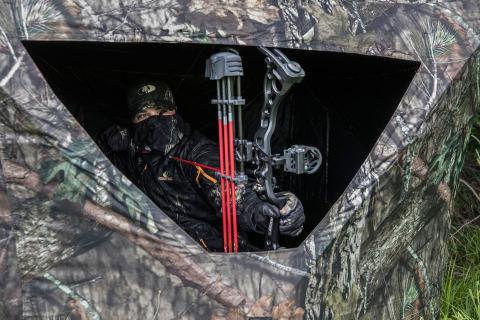Dana R. Rogers | Originally published in GameKeepers: Farming for Wildlife Magazine
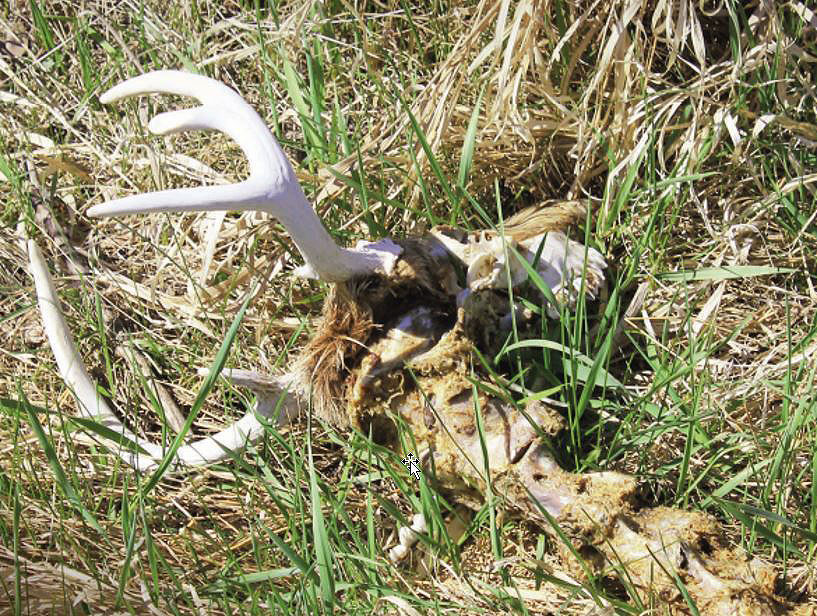
I felt sick to my stomach, I’d just got a good look at a trail camera picture of a great old buck I’d been watching for the past four years…and it wasn’t a pretty picture. His back right foot was snapped about 6 inches up his ankle and was swinging freely, attached only by a strip of hide. Immediately I knew what had likely happened and unfortunately what the likely result would be. You see, in my area of the Great Plains, it’s wide-open country for the most part, you can see for miles and miles in places. But it’s also populated enough and the terrain and land patterns are such that most sections have roads every mile. This means one thing, road hunters. A friend of mine calls all the people he sees driving by in their orange hats that are “hunting” from their vehicles “pickup princes.”
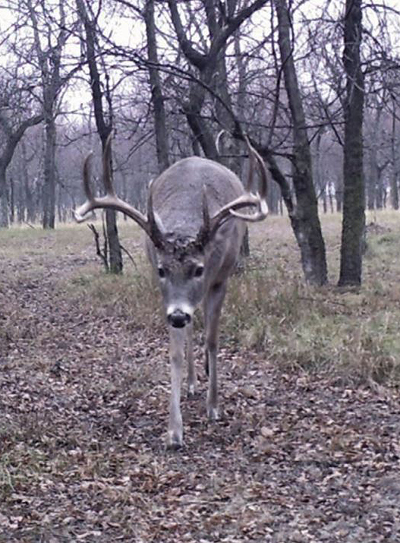
days.
The other sad practice that our wide open country enables is long-range shots. I’m not talking about precision loads and prone shots at broadside animals that are relaxed here; I’m talking about the totally irresponsible act of taking offhand shots at running deer at long ranges. That’s exactly what I believe happened to the buck I had named Double Wide, a name I gave him several years before after seeing my first trail camera picture of him. I estimated his inside spread at 24 inches-plus, by far the widest buck I’d ever seen. But I hadn’t seen him at all this season, in spite of targeting him specifically. Now the urgency was ramped up, he was wounded and although not immediately a fatal hit, I knew with the winter coming on, he’d have a heck of a time evading predators with only one good “back wheel.”
We Grow to Love them
It was an unanticipated byproduct of my land management efforts. I started managing our family land in hopes of changing the age structure and herd dynamics. I believed we could “grow our own” mature whitetails and change the way our family farm was hunted in order to produce a more aesthetically pleasing time afield. I’d grown weary of watching all the local hunters shoot the first antlered buck they saw, with no thought for the future. I’d also tired of the traditional local hunting practices of deer drives and “chases.” They worked great for producing shooting opportunities for the masses, but if we honestly assessed the results each season, we’d have to admit that an alarming number of wounded animals were caused by our deer drives and long-range running shots. That’s not an indictment so much of the general practice as much as it showed our total lack of practice and preparation as a group.
Whitetails are a resource that belongs to us all. But as gamekeepers, we invest our time, effort and often a great deal of capital to pursue our passion of managing our land for wildlife. Along the way, we connect with the land and the wildlife in a powerful way that many casual hunters have a hard time understanding.
After a few years of quality management and growing food plots, the results were impressive. I’d started to get pictures of bucks growing up from 2 through 3 and even 4-plus. I noticed the body distinctiveness, antler characteristics, facial features and individual personalities and markings like scars that allowed specific animals to be identified. Then I started identifying them personally and getting attached to some of them on an individual basis. That part of it was something I didn’t expect, and it’s definitely something that gets misinterpreted at times.
“They are just deer,” a neighbor once said tome. They are wild animals subject to the whims of their environment and man’s impact. We love to hunt them, watch them and enjoy them as God provided them for our use. But as each of you reading this knows, there are different levels of appreciation and interest for our beloved whitetail deer. Some hunters simply wish to “fill a tag” or “get their buck.” Some, unfortunately, could care less about how they do that and more about just getting it done. As gamekeepers, we have grown as hunters and outdoorsmen. We invest our time, effort and often a great deal of resources to pursue our passion of managing our land for wildlife. Along the way, we connect with the land and the wildlife in a powerful way that many casual hunters and sportsmen have a hard time understanding.
I’ve lost track of the numbers of people that have quipped “how are your deer doing”? Or even more frustrating, the guys that are angry about not being granted permission to hunt and falsely crow “that guy over there thinks he owns the deer!” I try to correct them and explain, but casual users of our resource will always have a hard time understanding the mentality of those of us who invest so much of ourselves to help and improve the shared resource.
They are Born, They Live and They Die
Gamekeepers strive to improve our habitat year-round, hoping to effect positive change in our hunting areas. I plant BioLogic Clover Plus for the lactating does to feed on early in the spring and to help jump start the bucks’ antler growth. Still, coyotes are on the prowl and will take some of the new fawn crop if we don’t keep the predator prey balance in check. We also lose a few during haying season as swathers and sickle-bar mowers cut down the alfalfa and prairie hay for cattle feed.
As those fawns grow into yearlings and 2-year-olds, we know from studies that they will likely disperse miles away in search of a new habitat and home range. In turn, we gamekeepers will receive yearling and 2-year-olds that move in from our neighbors. Trail camera surveys typically show a large number of those young bucks, obviously the largest portion of the antlered population numerically. We keep notes and identify individual bucks by their antler characteristics, but with those slight, sleek, “doe-like” adolescent males that remind me of pubescent boys, gangly and injected with their first dose of hormones come fall, it can be tough.
In our northern climate and agricultural country, we often see deer disperse great distances when deep snow hits after all the fields are bare from harvest. Our fields of BioLogic Maximum, corn and soybeans draws them in. The local population grows steadily as the November days tick off and December and January’s weather turns.
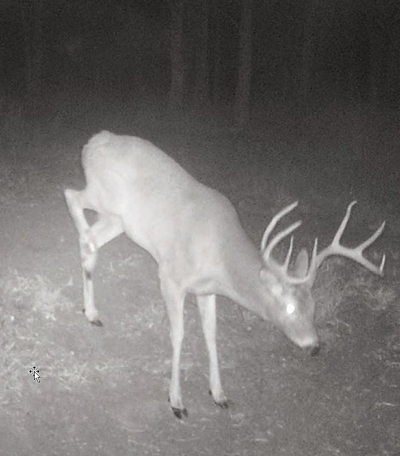
the wild, this injury is almost certainly fatal so the pursuit
was on to try and harvest the buck before he succumbed to
the injury. Trail cameras caught the buck up and moving
during legal shooting light, but none of the hunters could
make a connection to the buck before it was found dead
and scavenged.
During that early rut phase as the fields begin to turn to “biological deserts” post-harvest; we start to see more road kills. It seems I count at least one young buck that I’ve known from trail camera pictures lost to a fast moving Ford every November. In fact, a few years ago a great 3-year-old “up and comer” we’d been passing up met his demise a few miles away from our farm. He’d been lustily chasing a sweet smelling doe when he met a neighbor’s pickup on his way to work one frosty November morning. My uncle told my father about that particular buck and my father came to me with the news as I departed the field from my morning hunt. It was “just a deer,” but I’d known that particular buck and I had hopes he’d make it a few more ruts before someone placed a tag on his leg from a memorable hunt.
Salvaging Injured Whitetail Deer
Many friends shook their heads and thought I was crazy after I called the local conservation officer and patiently waited along the road for his instructions on how to legally “salvage” the animal. Yes, he was just a deer and I didn’t take him, but I respected him and wanted to salvage his skull for teaching purposes about quality management and age.
Then the late November and December migration happens. Our firearm seasons have come and gone and my trail cameras often show the results. Sometimes they are deer/car collisions; other times possible injuries from fighting or scars from barbed wire encounters. Other times, it’s obvious the animals made it through an encounter with a hunter, but not unscathed. Such was the case with Double Wide, the buck I targeted during the later part of the 2012 hunting season.
I checked my cameras looking for a pattern to hunt him effectively. He was still moving around well enough that I had hoped he’d move across a trail into the sights of my Hoyt Maxxis or CVA muzzleloader. He was an old deer, I estimated he was 6, and the thought of this magnificent buck going to waste after all he’d seen and been through caused me to shake my head. I tried every trick I could think of, I sat back from a distance and glassed with my spotting scope looking for him to break cover and head to the food plots. I sat over water and in every stand next to a camera that had taken his picture over the past few weeks.
It wasn’t a selfish feeling, I honestly didn’t care who tagged him. I just wanted it to be a legal and ethical hunt, a hunt worthy of such a mature and noble animal. I tried to position my father to get a shot at him. I enlisted the help of a young bowhunter that I mentor with instructions to come shoot him while we still could. I also showed his pictures to a few of our neighbors, hoping they would be able to catch him out during daylight and take the buck for themselves.
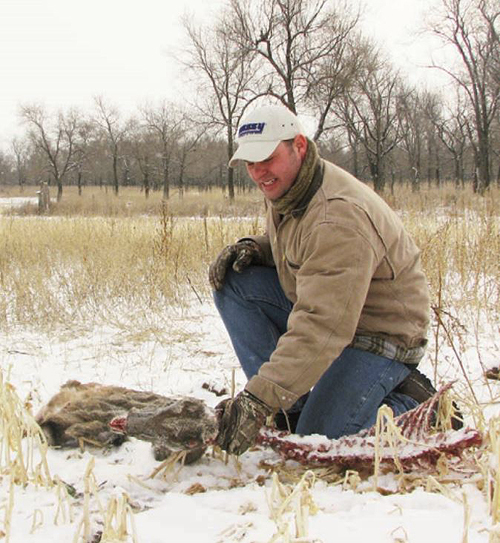
you begin to identify them personally and get attached to some of them on
an individual basis. It’s difficult when you find the remains of a buck that
you had this connection with.
My season ended in early December as I packed and departed for another deployment to Afghanistan. I really hoped my Dad, the young bowhunter or one of our neighbors would take Double Wide. In my absence, I hired a friend to check my cameras and look in on the place. The hunting seasons ended and the cameras were continually checked for sign of Double Wide and the other whitetail deer. A late December picture showed he was still alive but not surprisingly, he’d shed his antlers early, perhaps due to the stress of the injury.
The snow grew deeper and the temperatures colder. One day in late January I got an e-mail with news I was expecting with a bit of dread all along. My friend had found Double Wide’s skeleton picked nearly clean next to a field of BioLogic Clover Plus. The fractured ankle was a mess of infection and his pedicles showed the circumference of a great old warrior. Yes, he was “just a deer” but to a gamekeeper he was also a culmination of an investment of years and effort. He was akin to an old friend I’d only catch a fleeting glimpse of a few times a year on my trail cameras.
The Ides of March
The late winter period of mid-march isn’t just historically known as the great transition in Roman History and death of Caesar, it’s also the period in northern whitetail country when the herd is often times stressed out to the max. Winter is hopefully loosening its grip and a spring filled with growing forbs and clovers rescues the herd from starvation in time to begin a new cycle of life. It’s also the timeframe I usually hit the woods and fields each year to look for shed antlers. Inevitably, I also find the remnants of several deer that didn’t make it through the winter. By the time I do find them, there really isn’t much evidence left as to why they didn’t make it. The cycle of life for them was complete and they re-energized that cycle through the belly of predators and scavengers. Then spring comes around and we do it all over again.
We Can’t Keep them All Alive
Whether taken by a coyote as a fawn, road killed by a vehicle, poached, wounded during the season later to succumb or legally and ethically tagged or simply because they are old deer, they will all die eventually. They are wild animals, a renewable natural resource that we can only help along the way. Nobody “owns” the wildlife, but as gamekeepers, we feel the pride, connection and even a little bit of loss when something we’ve connected with isn’t there any longer. We can’t keep them all alive, but we can keep managing our landscapes so the next crop of whitetail deer is there to provide us the same enjoyment.
















